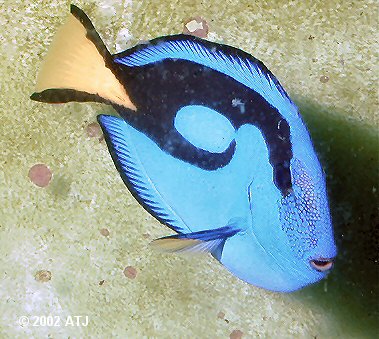
The Blue Tang in April, 2002
Tuesday 22 August 2006
Eight years ago today I acquired my blue tang, , my longest surviving fish, in recent times.
This fish was purchased from Strictly Aquariums in Yagoona along with two other blue tangs. At the time of purchase this fish was 30mm Total Length, with the other two fish at 40 and 25 mm TL respectively. These three blue tangs were effectively the first fish in a four foot tank I was using as a quarantine tank while waiting for my six foot tank to cycle. I say effectively as I had a Eibli angelfish that only survived a couple of weeks. The three tangs spent nearly five months in the four foot quarantine tank, including a period of three weeks when we went to the US and a friend visited daily to feed them on flake food.
When the six foot tank was ready, the three tangs were moved and they settled in quite well. Two weeks later I added a fourth tang. All four blue tangs got on very well for the next three years and nine months. All the tangs grew well and by October, 2001, this blue tang was around 80 mm TL, and its companions were 90, 75 and 50 mm TL, respectively,
In October, 2001, the good relations between the tangs broke down. The largest tang became very aggressive to this tang, which was the second largest. The attacks were relentless and continued for two weeks. This tang was not able to feed and I was only able to catch it when it was weakened and highly stressed.
I moved this tang to my three foot quarantine tang where it "sat" in the corner of the tank for four days without feeding. It was breathing heavily and was badly cut from the encounters with the other tang. Eventually, it ventured out and started to feed. Gradually, it grew more and more confident and was soon back to normal and the cuts healed.
The tang spent four and a half months in the quarantine tank until I got another six foot tank ready. During this time it grew another couple of centimetres in length, and actually grew faster than the tang that had been attacking it.
In March 2002, I moved the tang to my new 180 gallon FOWLR along with three wrasses (, Coris gaimard, ) and four Psuedanthias spp.. (3 , 1 ), but I lost one of the P. pictilis from shock after the move.

The Blue Tang in April, 2002
These fish did very well together until May 2002 when I introduced a and a . Unfortunately, I had not quarantined the Forcipiger long enough, just 28 days since I had caught it at Seal Rocks, NSW. A week after introduction, the tang, Heniochus, Forcipiger and Pseudanthias all showed signs of "Ich". The three wrasses showed no signs at all. I attempted to catch the infected fish so I could treat them in the quarantine tank, but had no luck at all and realised I'd have to sit it out. I soaked the food with garlic juice in the hope that this may help. Over the next three months, the fish went through six to eight cycles of "Ich". Two of the Pseudanthias didn't make it and neither did the Heniochus, however, the blue tang and the Forcipiger made full recoveries and by September, 2002, neither showed any further signs of "Ich".

The Blue Tang in January, 2003
In February and March 2003, the three blue tangs in the old six foot tank died mysteriously. They each died a week or so apart from each other and the only signs were difficulty swimming. This leaves this last blue tang as my longest surviving fish since starting my tanks afresh in 1998.
The blue tang is now approximately 170 mm TL with a healthy width and "happy" disposition. The fish eats just about everything it is fed, including shrimp, squid, scallops, pellets, nori and spirulina.